My January trip to Singapore became a vibrant lesson in Peranakan heritage, all thanks to a dear friend. Over delicious Kaya toast and kopi, he shared his family history as a third-generation Indonesian-born Chinese and his cultural identity. He also helped me to understand the meanings of ‘Peranakan’, ‘Nyonya’ and ‘Baba’. Our breakfast conversations became a memorable cultural exchange.
Inspired by my friend’s insight, I visited the Peranakan Museum and Asian Civilisations Museum in Singapore to further explore this fascinating culture.
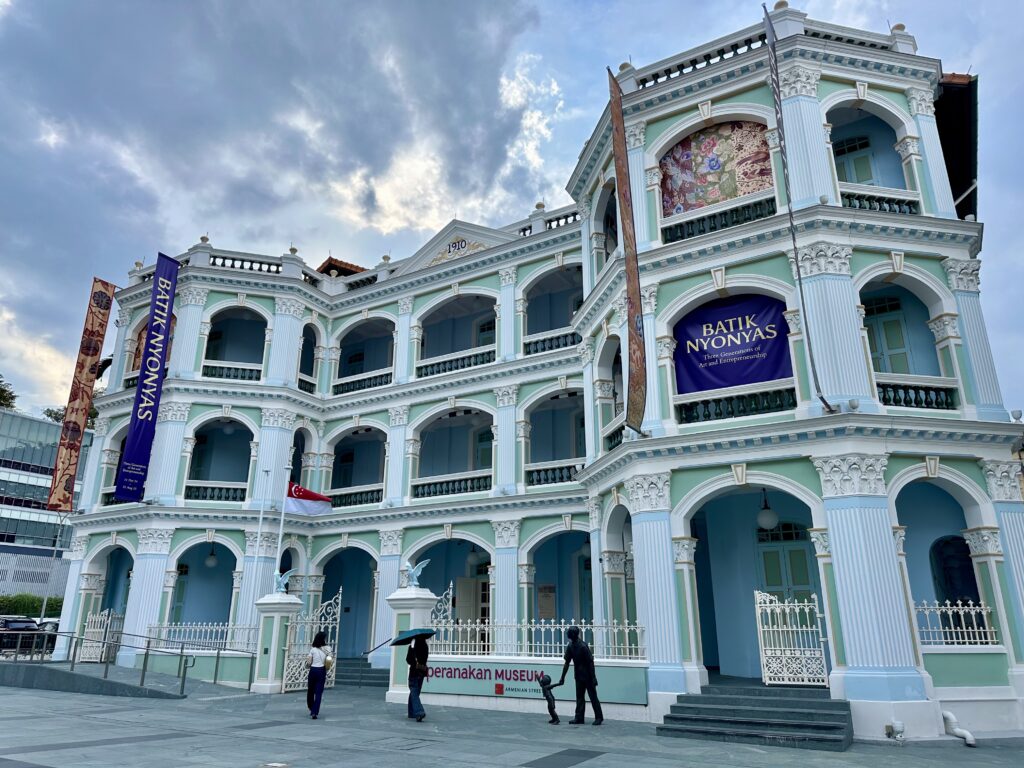
Peranakan Museum, Singapore (photo private)
In Malay, ‘Peranakan’ stems from ‘anak,’ meaning ‘child’ or ‘womb.’ This term identifies people born within the Straits Settlements, as well as those born from mixed foreign and local parentage. It applies to the long-established, locally born Chinese communities of the former Straits Settlements, whose members often had mixed ethnic backgrounds.
To truly appreciate Nyonya ware, understanding the cultural context of the ‘Baba’ and ‘Nyonya’ is essential.
In the Straits Settlements, the Peranakan were commonly called Straits Chinese. The term ‘Baba’, originating from the Hindu word ‘babu’ meaning ‘clerk’, became associated specifically with Straits Chinese men due to their prevalence in clerical roles within the nineteenth century British colonial civil service.
The corresponding female honorific, ‘Nyonya,’ was more widely used, encompassing Peranakan women in Sumatra and Java as well, where it often became ‘Nona.’ Together, ‘Baba Nyonya’ emerged as an alternative term for both Peranakan and Straits Chinese, signifying this distinct community.
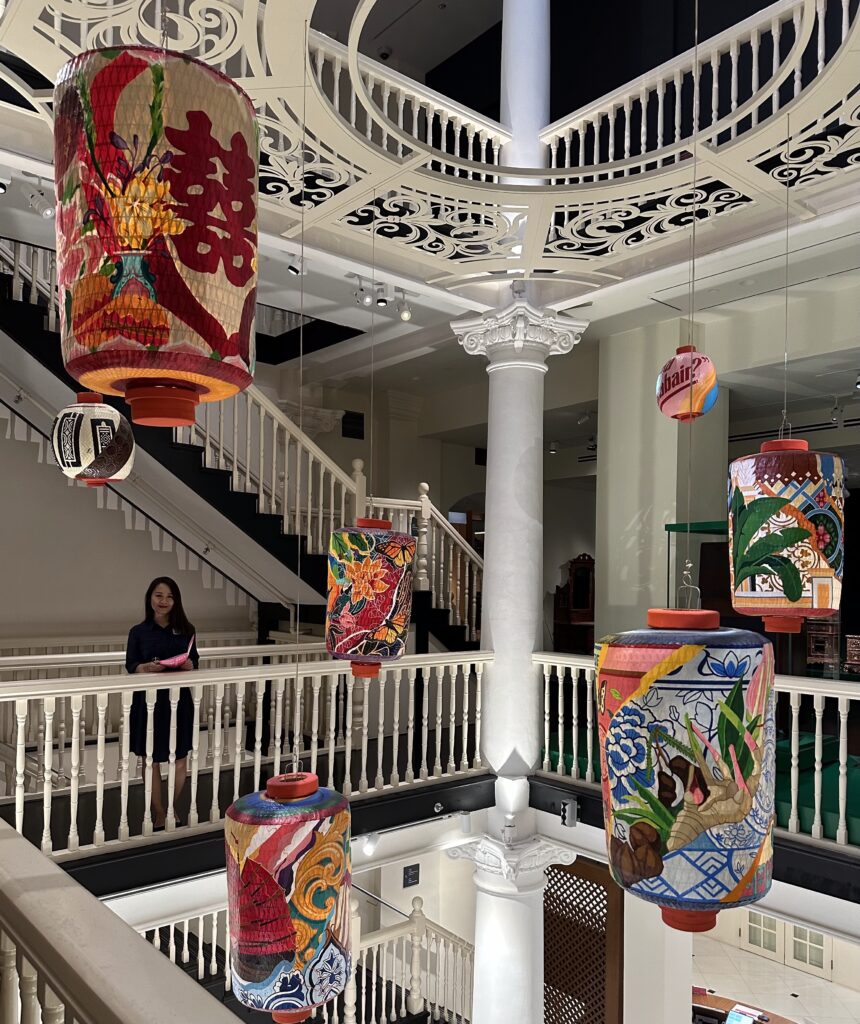
Peranakan Museum, Singapore (photo private)
There can be no doubt that Peranakan Chinese porcelain was specifically created to serve the utilitarian needs and artistic preferences of the Straits Chinese, and was produced solely for their consumption. It is plausible that many were not even aware of its existence.
Nyonya ware
Nyonya ware, the distinctive overglazed polychrome enamelled porcelain often associated with Peranakans, was likely produced in Jingdezhen, China.
Polychrome enameling, quite simply, means ‘many-colored,’ stemming from the Greek words ‘poly’ and ‘chroma.’ It’s a fascinating process where artists layer colored glass powders, or enamels, onto a pre-glazed ceramic piece.
First, the ceramic is given a base glaze and fired at a high temperature. Then, these finely ground enamel powders, mixed with a binder to create a paintable consistency, are carefully applied. Finally, a second, lower-temperature firing melts the enamels, bonding them to the glaze and creating a stunning, richly colored, and exceptionally durable surface.
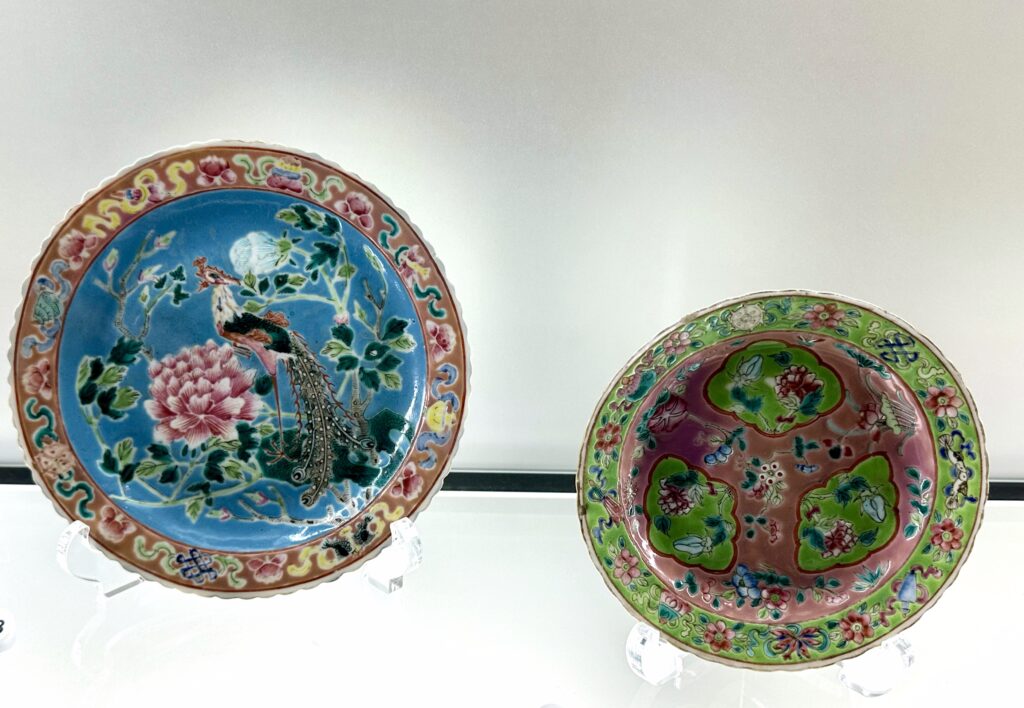
Left: Plate. China, Qing dynasty (Guangxu period, 1875–1908) Porcelain. Mark: 光緒年制 (Guang Xu Nian Zhi) (photo private)
Right: Dish. China, Qing dynasty (Guangxu period, 1875–1908) Porcelain. Mark: 光緒年制 (Guang Xu Nian Zhi) (photo private)
Named for the Peranakan Chinese women who prized it, Nyonya ware is characterized by a lavish use of color, with green as the principal background and frequent pairings with pink. The dish on the right above exemplifies Nyonya ware’s typical green and pink palette.
In contrast to the broad range of decorative motifs found on Chinese porcelain and other art forms, Nyonya wares typically feature a limited selection of motifs, primarily flowers, birds, and insects. Notably, the phoenix and peony, both natural elements, are frequently paired, symbolizing prosperity and virtue.
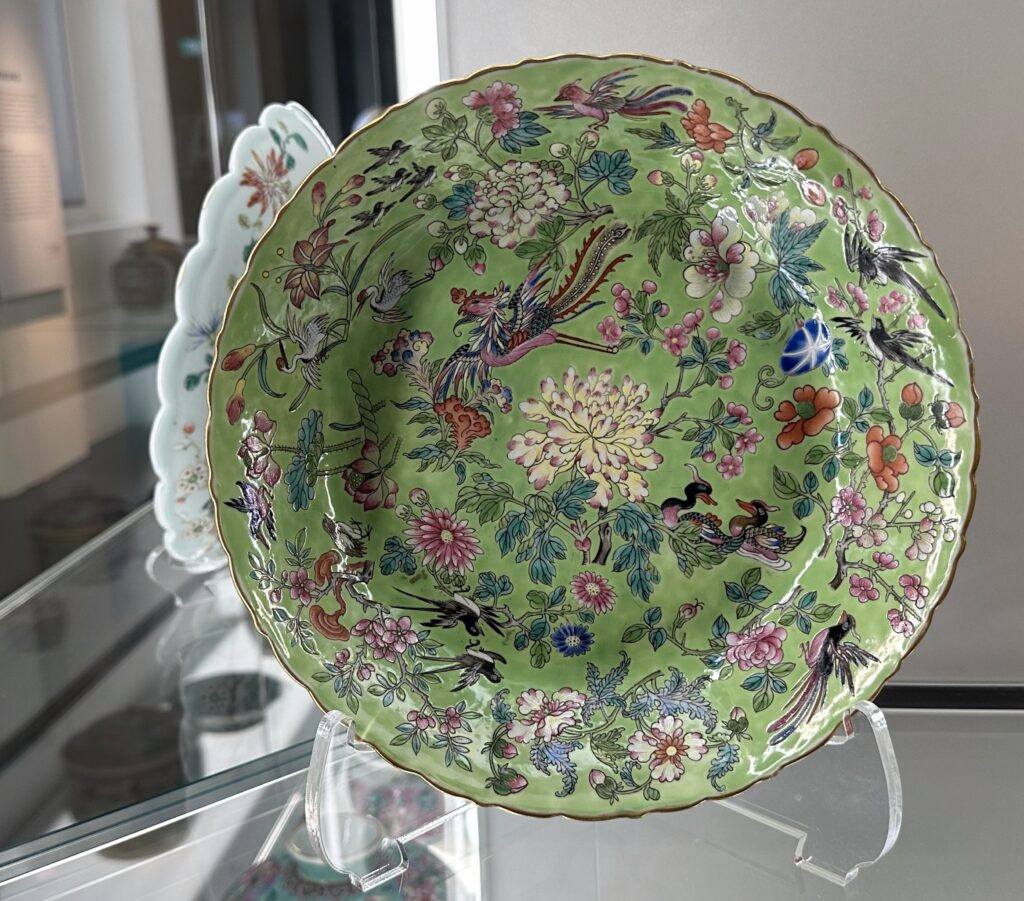
Dish. China, Qing dynasty (Daoguang period, 1821-50), porcelain. Mark: 大清道光年制 (Da Qing Dao Guang Nian Zhi), Peranakan Museum, Singapore (photo private)
Flowers, deeply connected to nature, are significant symbols in Buddhism, particularly the lotus, which represents purity as its beautiful blossom emerges from muddy waters. The peony, revered as the ‘flower of wealth and honor,’ is also the most esteemed flower in Chinese culture. The phoenix (fenghuang), known in China as the ’emperor of the feathered tribe,’ symbolizes supreme beauty and grace.
Tok panjang
Peranakan families commissioned elaborate dining sets for festive occasions, like birthdays and Lunar New Year, often bearing family marks.
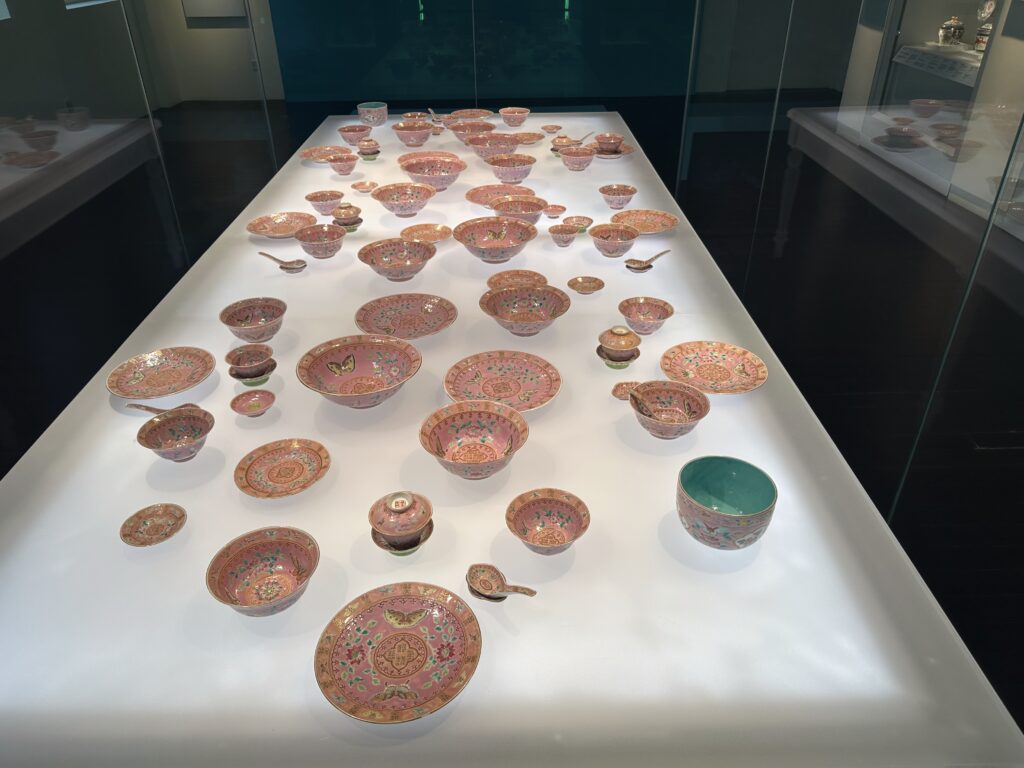
Tok panjang, Yap dining wares. Peranakan Museum, Singapore (photo private)
To ensure guests’ comfort, multiple small serving dishes were arranged along the table. This is seen in Kapitan Cina Yap Ah Loy’s commissioned tok panjang set (Baba Malay for “long table”), designed for grand feasts. Featuring sixteen distinct plates, bowls, and spoons, each with a specific purpose, these sets, used for special events, blended European, Chinese, and Malay influences, showcasing unique dishes and desserts.
The pieces are decorated both on the interior and exterior with auspicious motifs of butterflies and flowers. The character for the name “Yap”, 葉, is printed on the rim. The mark on the base is of De Sheng Gong Si 德生公司, the name of Yap Ah Loy’s shop in Kuala Lumpur.
This dinner set demonstrates the individualized commissioned porcelain common in Peranakan tok panjang feasts.
Spittoon
Following the meal, it was common for betel quids (sireh) to be served, continuing a practice spanning thousands of years in Asia. Betel chewing was once a social necessity across Southeast Asia, deeply embedded in Indian and Peranakan communities. While often referred to as ‘betel chewing,’ the actual item consumed is the ‘betel quid,’ composed of betel leaf, areca nut, and slaked lime. This chewing results in copious red saliva, leading to frequent spitting.
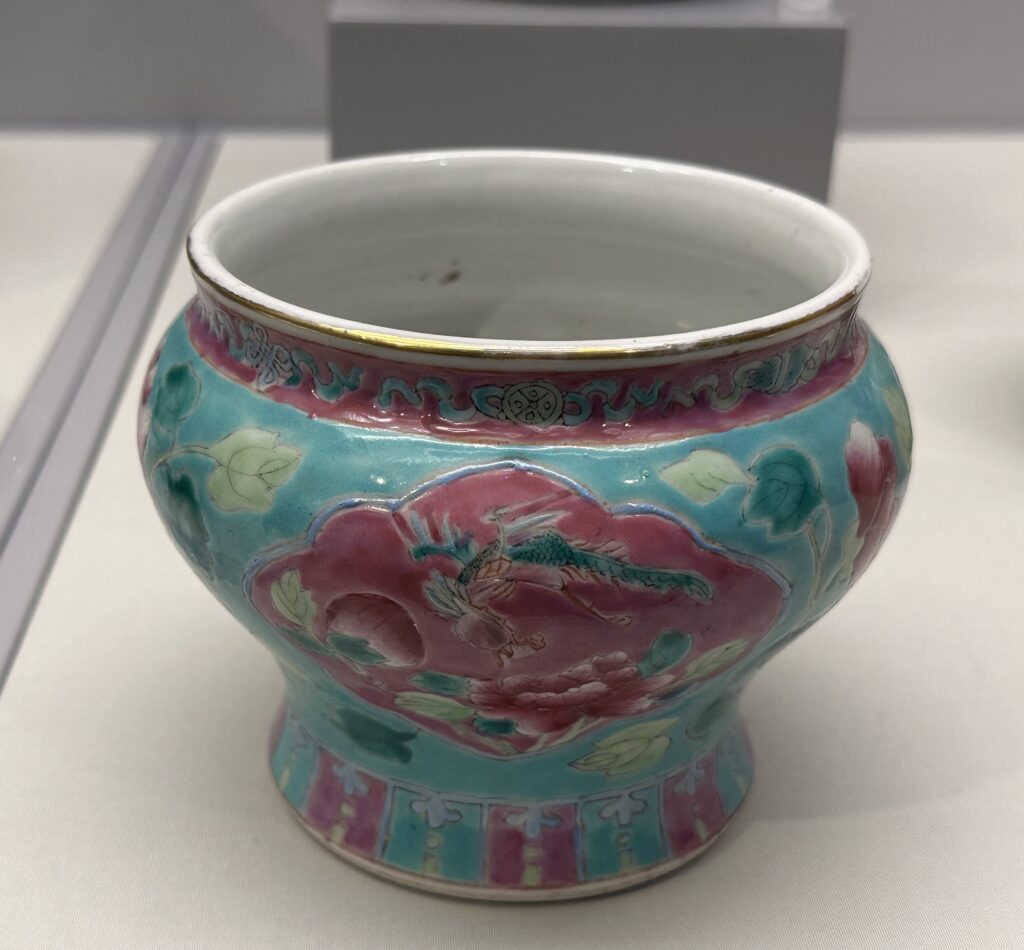
Spittoon. China, late 19th or early 20th century, porcelain. Asian Civilisations Museum, Singapore (photo private)
In nineteenth and early twentieth century Singapore and Malaya, the betel quid was enjoyed widely, irrespective of class or gender, especially after meals for its digestive and breath-refreshing effects.
As a direct response to the betel chewing tradition, the spittoon emerged as a functional and integral element of Peranakan domestic culture.
Kamcheng
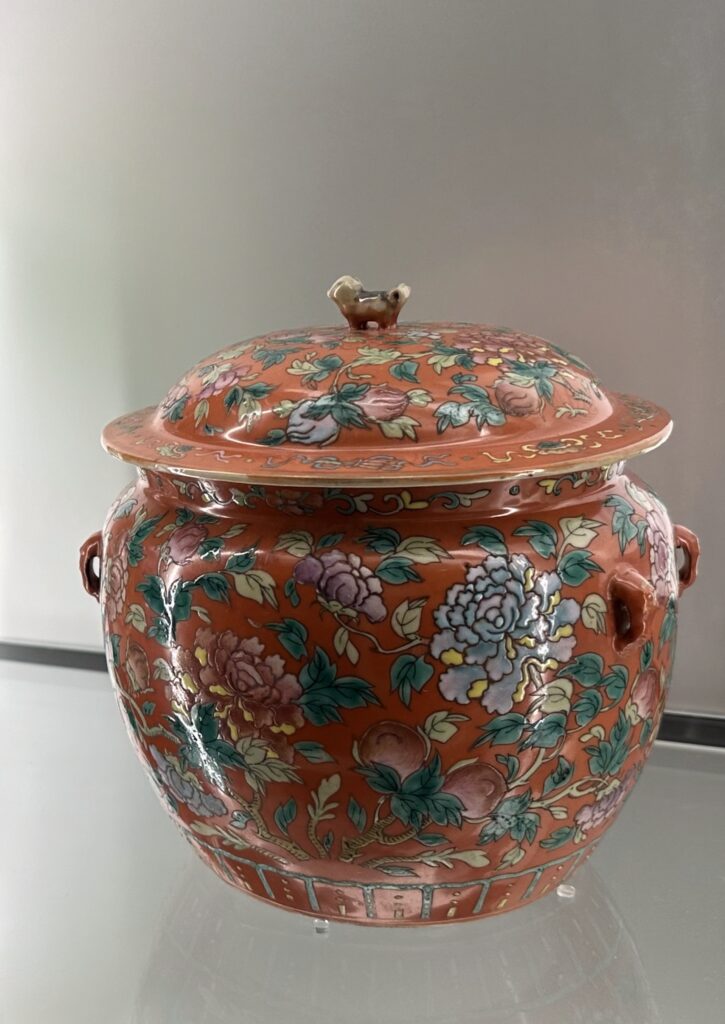
Kamcheng. China, Qing dynasty (Guangxu period, 1875–1908) Porcelain. Asian Civilisations Museum, Singapore (photo private)
In the Hokkien dialect, kamcheng means ‘covered vessel’.
The precise purpose of the kamcheng within Peranakan Chinese households remains uncertain. However, it is established that the kamcheng held a significant role in their wedding rituals. It served as a vessel for transporting various types of food and sweetmeats to the bridal chamber during the twelve-day wedding celebrations, and subsequently, during a Nyonya’s postpartum confinement.
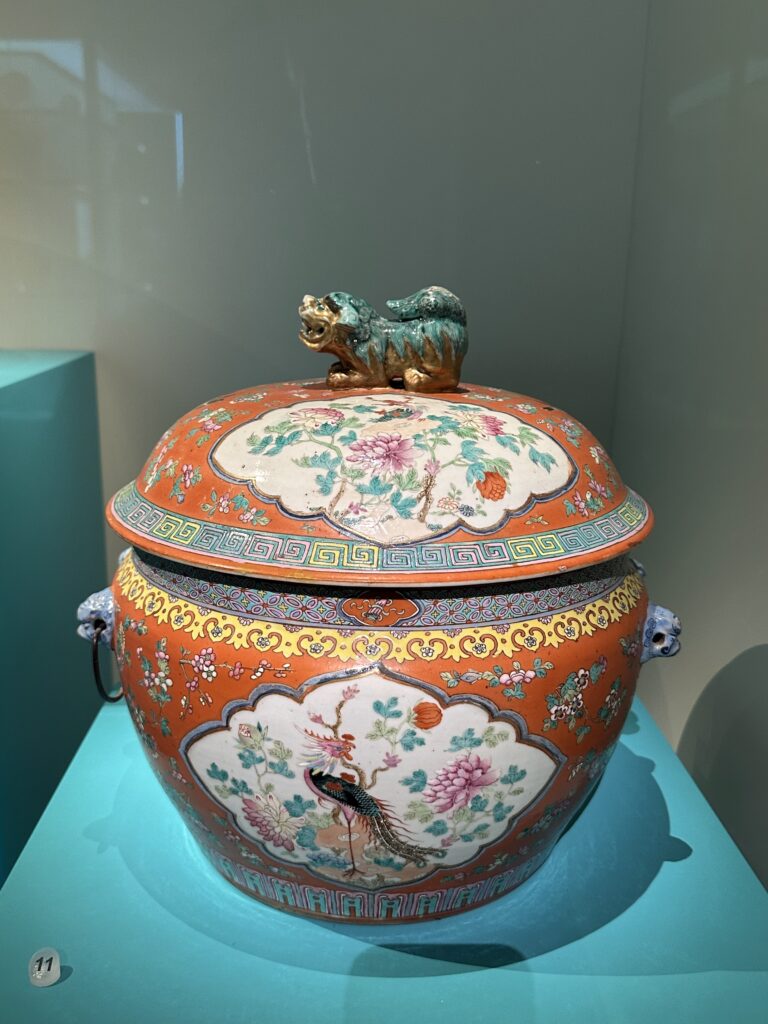
Kamcheng. Asian Civilisations Museum, Singapore (photo private)
The above kamcheng is unusually large and in rare colour- coral red.
The Buddhist guardian lion or lion-dog, in moulded form, mostly crouching but sometimes standing, frequently forms the finals of lids on kamcheng.
These are examples of some of the best and rarest Nyonya ware, because of their exceptional size, unusual forms and colours, and the quality of their enamel decoration. The functions of these pieces reflect the cross-cultural nature of Peranakan life.
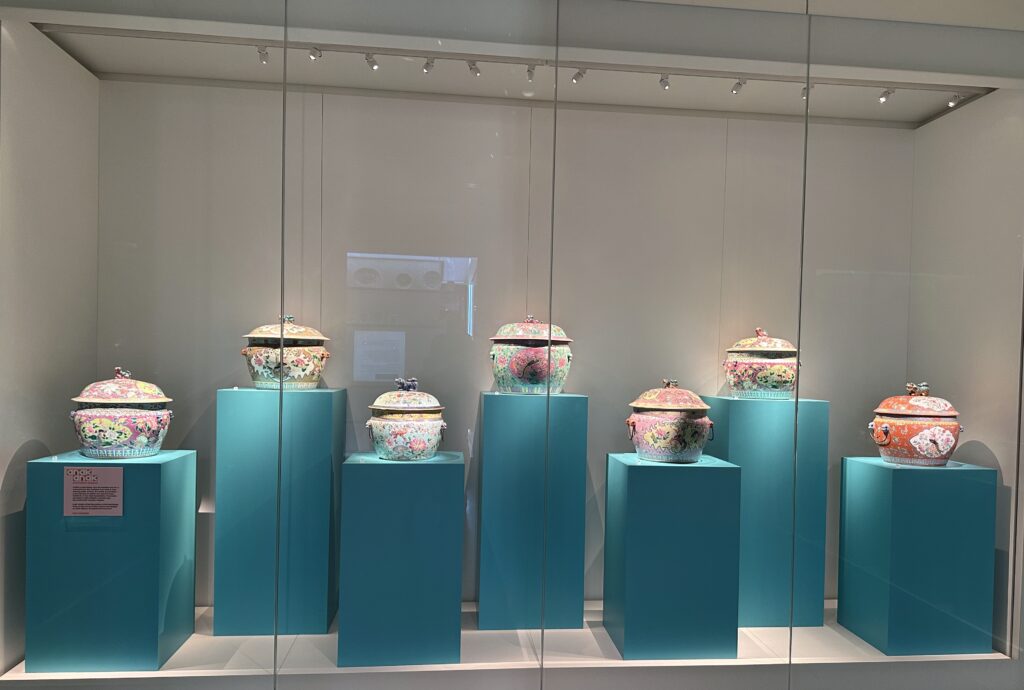
Kamchengs. Asian Civilisations Museum, Singapore (photo private)
Katmau
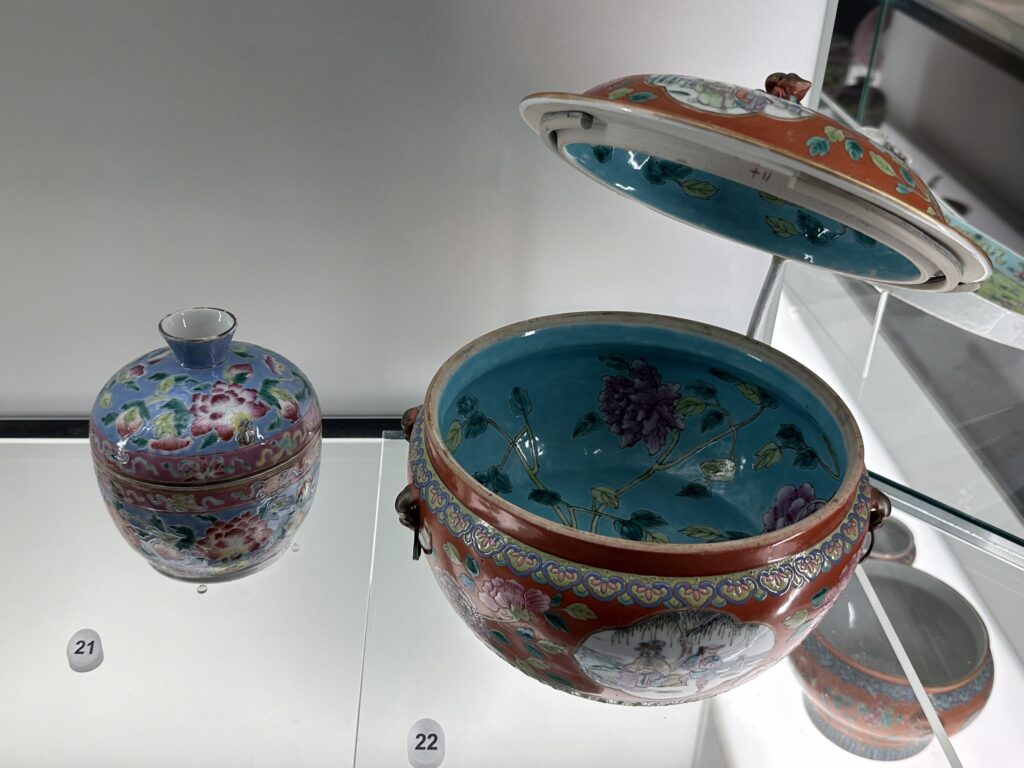
Left: Chupu. China, Qing dynasty (Guangxu period, 1875–1908) Porcelain. Mark: 光緒年制 (Guang Xu Nian Zhi) Asian Civilisations Museum, Singapore (photo private)
Right: Kamcheng. China, Qing dynasty (Guangxu period, 1875–1908) Porcelain. Mark: 大清光緒年制 (Da Qing Guang Xu Nian Zhi) Asian Civilisations Museum, Singapore (photo private)
While also a covered jar, the katmau (or chupu as it is known in Malacca, and himcheng in Penang) differs significantly from the kamcheng in appearance and is noticeably more delicate. Though its exact function remains unclear, its form suggests it was intended for food storage. As a key component of Peranakan Chinese wedding rituals, alongside tea sets and kamcheng, katmau likely held symbolic delicacies like bird’s nest soup and glutinous rice balls in syrup, which the newlyweds shared as their first act of mutual service.
The above miniature katmau could have been used by Nyonyas to hold bedak sejuk (literally ‘cooling powder’ in Malay), rice powder used as astringent cosmetic for closing facial pores and smoothing the skin, or perhaps to store trinkets and other small objects.
Entirely enameled pieces have colored enamel decorations covering at least their outer surface. Occasionally, as seen in the kamcheng on the upper right, both the inside and outside are decorated with colored enamels. It’s thought that this double-sided enamelling indicated the owners’ abundant wealth, as they were able to pay for such comprehensive decoration.
Peranakan Chinese porcelain, or Nyonya ware, embodies the fusion of cultures in the Straits Settlements. Commissioned for festive occasions and everyday life, these ceramics are a testament to the multiculturalism and globalization that shaped the Peranakan identity.
Photo: Marc Lauterfeld